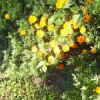I have a Hydrangea and a Mallow Hibiscus each about 9 months old. They are in the ground , in poor soil. What fertilizer should be used on each to promote growth and flowers? Thanks.
Hardiness Zone: 6a
By BJ from MO
Add your voice! Click below to answer. ThriftyFun is powered by your wisdom!

Hydrangeas grow best if they are fertilized once or twice in the summer. Although some authorities recommend special fertilizer mixes to get the maximum results, hydrangeas do amazingly well with a more relaxed approach.
Either chemical fertilizers or organic matter can be used successfully. Since an organic method of applying manure and/or compost around the roots, produces excellent results and also improves the condition of the soil, this would be an excellent first line of attack. Organic additions to the soil can also be combined with a shot of chemical fertilizer for maximum effect.
If chemical fertilizers are used, applying a slow-release, balanced fertilizer once a year is probably the simplest solution. There are many slow-release fertilizers on the market. If you can find a fertilizer formulated for shrubs and trees, this fertilizer would work well on hydrangeas. If Osmocote is used, the granules MUST be covered with soil for the fertilizer to release properly.
However, slow-release is certainly not the only way to fertilizer hydrangeas. A less expensive fast release fertilizer such as a 10-10-10 will work just as well if applied twice during the summer. If you are looking for a fertilzing routine tailored to your specific conditions, a soil sample should be taken and the fertilizer and trace elements matched to the needs of your soil.
Don't fertilize after August. Fall is the time for hydrangeas to begin preparing for dormancy. Fertilizing at this time may stimulate new growth that will be too tender to withstand the winter. In the South, a late May application and another in July would be about right. More northern areas may wish to fertilize only once in June or July.
The amount of chemical fertilizer used per plant will vary with the size of the plant and it's root system. (Use less fertilizer for hydrangeas in a container.) Over-fertilization can be much more detrimental than under-fertilization. "Fertilizer burn" can occur when too much fertilizer is applied, resulting in a drying out of the roots and damage or even death of the hydrangea.It is much, much better to err on the side of too little fertilizer than too much. When roots are burned, the first sign is often scorched looking leaves. If overfertilization is severe, the plant may just wilt and die.
If you are a beginner at growing plants, it may be helpful to know that a very small plant which is planted in the ground will take about 1/8 - 1/4 cup of fertilizer. When fertilizing hydrangeas in pots, be careful to apply a fertilizer that will not burn the roots (such as a slow release or a liquid fertilizer). A very large shrub in the ground will take 2 - 3 cups spread around the drip line of the branches (not next to the trunk). This is a very loose estimate, so please read the directions on the fertilizer before applying it.
If a liquid fertilizer is used, it should be applied every month for both plants in pots and in the ground.
Never fertilize a plant with a chemical fertilizer if the plant looks sick or wilted. If a plant is struggling due to a disease or root problems, the fertilizer will only add stress to it's life. Try to cure the problem before adding fertilizer.
For an organic approach, many gardeners use commercial manure on the soil around hydrangeas. Excellent results have been reported by visitors to this site after using composted manure. Commercial manure or compost can be applied yearly around the base of the hydrangea. As with chemical fertilizers, do not apply it right next to the trunk or stems emerging from the ground.
good luck.
Add your voice! Click below to answer. ThriftyFun is powered by your wisdom!